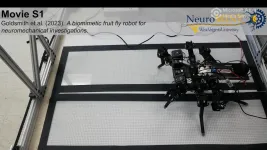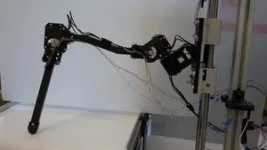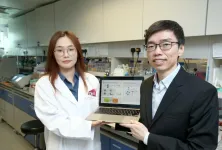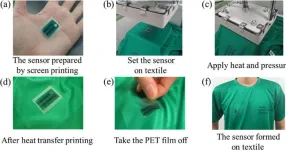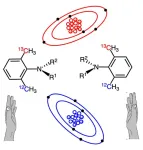(Press-News.org) Researchers have combined research with real and robotic insects to better understand how they sense forces in their limbs while walking, providing new insights into the biomechanics and neural dynamics of insects and informing new applications for large legged robots.
Campaniform sensilla (CS) are force receptors found in the limbs of insects that respond to stress and strain, providing important information for controlling locomotion. Similar force receptors exist in mammals known as Golgi tendon organs, suggesting that understanding the role of force sensors in insects may also provide new insights into their functions in vertebrates such as humans.
“I study the role of force sensors in walking insects because these sensors are critical for successful locomotion,” says Dr Szczecinski, an assistant professor in the Department of Mechanical and Aerospace Engineering in the Statler College of Engineering and Mineral Resources at West Virginia University, USA. “The feedback they provide is critical for proper posture and coordination.”
The benefits of building robotic models over computer models include more realistic modelling of friction between moving parts and the inclusion of delays to send neural signals. Robotic limbs also have the advantage of being able to record the sending and receiving of every single signal and resulting mechanical actions, which is not possible with animals.
“Walking is an inherently mechanical task, so understanding the neural control of walking requires simultaneously investigating mechanics and neural control,” says Dr Szczecinski. “Properly functioning walking robots can serve as prototypes for machines that could help people farm in extreme terrains, explore other planets, or walk through forests to monitor their health.”
Dr Szczecinski has two main research robots: the first is a biomimetic robot based on the fruit fly (Drosophila melanogaster) which walks on 6 legs, enabling the team to capture a complete picture of how campaniform sensilla monitors forces while walking. The other robot is a single leg, which allows for a simplified simulation of the sensory experience of one insect leg while walking.
Dr Szczecinski also explores the role of CS in real insects by isolating their limbs and monitoring sensory pathways with electrodes when different forces are applied. These recorded sensory signals are then used to develop models for the robotic legs.
“By recording their response to many different signals, we can paint a clearer picture of how they convert forces into neural activity,” says Dr Szczecinski. “We use many different stimuli because the CS are highly dynamic and are always adapting to the applied forces.”
Dr Szczecinski’s research has revealed very strong correlates between their real insects and robotic counterparts. “We find that for every insect species we check, our model is equally well equipped to describe the way the CS turn forces into neural activity,” says Dr Szczecinski. “This suggests that each species’ organs are broadly functioning in the same way.”
END
Big robot bugs reveal force-sensing secrets of insect locomotion
2023-07-06
ELSE PRESS RELEASES FROM THIS DATE:
How dietary restraint could significantly reduce effects of genetic risk of obesity
2023-07-06
Obesity risk genes make people feel hungrier and lose control over their eating, but practicing dietary restraint could counteract this.
New research by University of Exeter, Exeter Clinical Research Facility, and University of Bristol – funded by the Medical Research Council Doctoral Training Partnership and published in the International Journal of Epidemiology - found that those with higher genetic risk of obesity can reduce the effects that are transmitted via hunger and uncontrolled eating by up to half through dietary restraint.
Psychology PhD student, Shahina Begum, from the University of Exeter is lead author and said: “At a time when high ...
Webb Telescope detects most distant active supermassive black hole
2023-07-06
Researchers have discovered the most distant active supermassive black hole to date with the James Webb Space Telescope (JWST). The galaxy, CEERS 1019, existed about 570 million years after the big bang, and its black hole is less massive than any other yet identified in the early universe.
In addition to the black hole in CEERS 1019, the researchers identified two more black holes that are on the smaller side and existed 1 billion and 1.1 billion years after the big bang. JWST also identified eleven galaxies that existed when the universe was 470 million to 675 million years old. The evidence was provided ...
Unveiling the secret of viruses-bacteria interactions in man-made environments
2023-07-06
Viruses in man-made environments cause public health concerns, but they are generally less studied than bacteria. A recent study led by environmental scientists from City University of Hong Kong (CityU) provided the first evidence of frequent interactions between viruses and bacteria in man-made environments. It found that viruses can potentially help host bacteria adapt and survive in nutrient-depleted man-made environments through a unique gene insertion.
By understanding these virus–bacteria interactions and identifying the possible spread of antibiotic ...
ASBMB weighs in on changes to NIH fellowship review
2023-07-06
The American Society for Biochemistry and Molecular Biology sent feedback in June to the National Institutes of Health about its proposed changes to the Ruth L. Kirschstein National Research Service Award fellowship application and review process.
The proposed changes indicate that the NIH adopted nearly all of the ASBMB’s earlier recommendations (here and here) to reduce institutional and investigator bias and refocus the evaluation on an applicant’s potential and the impact of the ...
Wastewater monitoring could act as pandemic early warning system
2023-07-06
Wastewater monitoring could act as an early warning system to help countries better prepare for future pandemics, according to a new study.
An international collaboration involving Murdoch Children’s Research Institute, The Rockefeller Foundation, Mathematica and the United Kingdom’s Health Security Agency has shed light on how different countries monitor wastewater during infectious diseases outbreaks and where improvements could be made.
For the study, samples from treatment plants, rivers, wetlands and open drains were reported ...
T cells require healthy “power plants”
2023-07-06
All cells have their own power plants, called mitochondria. There are often more than 100 mitochondria per cell and each possesses their own genome, which in turn contains genes responsible for energy production. If errors creep into these genes, this can cause problems in the cell and result in diseases. Scientists from the Berlin Institute of Health at Charité (BIH) and the Max Delbrück Center have now discovered that the T cells of the immune system are especially sensitive to genetic disturbances within their mitochondrial power plants. They have published their findings ...
Sweat it out: Novel wearable biosensor for monitoring sweat electrolytes for use in healthcare and sports
2023-07-06
The remarkable level of miniaturization possible in modern electronics has paved the way for realizing healthcare devices previously confined to the realm of science fiction. Wearable sensors are a prominent example of this. As the name suggests, these devices are worn on the body, usually directly on the skin. They can monitor important bodily parameters, including heart rate, blood pressure, and muscle activity.
Some wearable sensors can also detect chemicals in bodily fluids. For instance, sweat biosensors ...
New teaching method can even out children's reading skills
2023-07-06
How well do children know letters and their corresponding sounds? In Norway, the gender difference on these tasks when children start school is significant. The girls have a clear head start.
“We see these differences in all categories – for upper case and lower case letters, for the names of the letters and for their corresponding sounds,” says Hermundur Sigmundsson, a professor at Norwegian University of Science and Technology's (NTNU) Department of Psychology.
Girls’ letter-sound knowledge is clearly better than that of boys,’ and girls remain far better readers than boys at age 15. Since reading is key for so many ...
Scientists synthesize isotopic atropisomers based on carbon isotope discrimination
2023-07-06
In chemistry, a molecule or ion is said to be chiral if it cannot be superposed on to its mirror image by any combination of rotations, translations, or conformational changes. A chiral molecule or ion exists in two forms, called enantiomers, that are mirror images of each other; they are often distinguished as either ‘right-handed’ or ‘left-handed’ by their absolute configuration. Enantiomers exhibit similar physical and chemical properties, except when interacting with polarized light and reacting with other chiral compounds, ...
New study shows robust pandemic preparedness strongly linked to lower COVID-19 mortality rates
2023-07-06
New Study Shows Robust Pandemic Preparedness
Strongly Linked to Lower COVID-19 Mortality Rates
Preparedness matters: Accounting for age and national capabilities to diagnose COVID-19 deaths reveals that pre-pandemic investments in capacity saved lives—though U.S. remains an outlier.
The vast majority of countries that entered the COVID-19 pandemic with strong capacity to prevent, detect, and respond to disease threats achieved lower pandemic mortality rates than less prepared nations, ...
